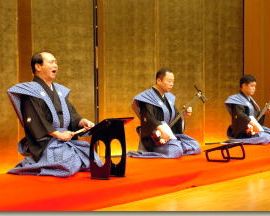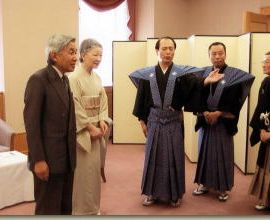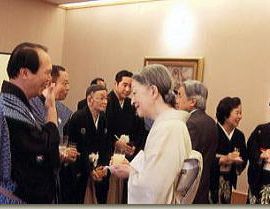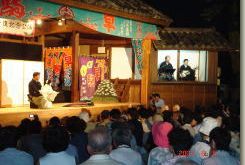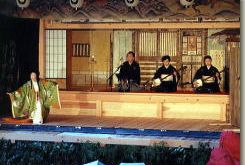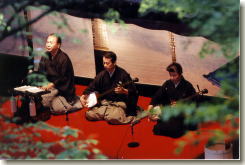Performance in the Presence of Their Imperial Majesties
On September 10, 2005, the Emperor and Empress were in attendance at Wakasanojo’s recital. Although the Imperial Couple often attend the recitals of performers in other traditional fields, this was the first time that they had been in attendance at a shinnai performance.
Domestic Performances
Because Wakasanojo believes in the importance of advocacy in music education, he performs frequently at locations throughout Japan, in addition to his extensive performances in other countries. Every year, his performances are increasingly in demand in Japan.
Tokushima, located on Shikoku Island, is said to be the birthplace of traditional Japanese puppet theater, in which the puppets act out stories that are narrated in song as well as spoken words, with the storyteller accompanied by shamisen music. Recently, there has been a movement to save and revive rural theaters in Tokushima. Wakasanojo is deeply involved in that activity. Haigu Theater is located in the mountains, surrounded by trees, a two-hour drive from Tokushima City. Other theaters in this area include Iya Theater, which is famous because Heike warriors took refuge there 1,000 years ago, and Hayashizaki Theater in Anan City. Wakasanojo performs at these theaters every year, and actively supports the movement to restore, maintain, and use these traditional theaters.
In Takayama City in Gifu Prefecture, many buildings are preserved in their historic condition. Every summer, Wakasanojo strolls along the beautiful streets, playing shinnai nagashi. Many Takayama residents, as well as tourists, gather to enjoy his traditional performance.
Wakasanojo serves as the honorary director of the concert hall of Matsuto Learning Center in Hakusan City, Ishikawa Prefecture. The area where Hakusan City is located was traditionally called Kaga. In the early 18th century, a woman named Chiyo-jo who lived there was a distinguished Haiku poet. The town maintains a Chiyo-jo Haiku Museum, and even now has a strong cultural tradition that includes haiku. Wakasanojo performs in Hakusan City several times each year. In addition, he introduces the arts of Edo at the Matsuto vaudeville theater by inviting guest performers.
Wakasanojo’s relationship to Yamagata Prefecture is deep. He has been teaching shinnai there for 20 years. Moreover, he regularly has joint performances there with local dancers. Wakasanojo’s friends know that he loves soba noodles. His favorite noodle shop is located in the heart of the mountains of Yamagata. He sometimes goes to Yamagata only in order to eat noodles there.
Wakasanojo’s other activities are too numerous to list. His activities extend throughout Japan, including Nagano, Osaka, and Hokkaido. His goal is to develop a broad audience for shinnai, so as to ensure its future.

